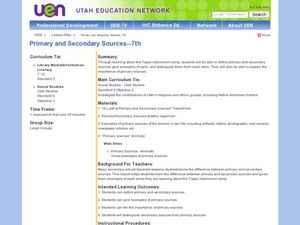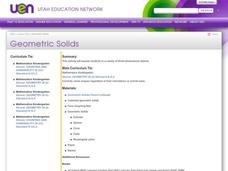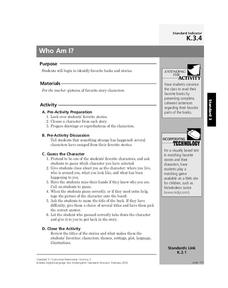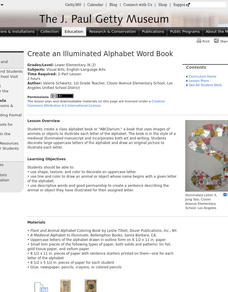Curated OER
Comparison Shopping
Elementary schoolers explore the concepts associated with comparison shopping, and the concept of need versus want. They also look closely at the power of advertising and become more aware of the messages that ads present. After taking...
Curated OER
Alphabet Tic-Tac-Toe
Use online resources to aid young readers' phonemic awareness. They will look at various sources to practice letter-sound relationships. They also are assessed using a rubistar rubric. Quite a few resources are given for this lesson.
Agriculture in the Classroom
"Steer" Toward STEM: Careers in Animal Agriculture
Think like an engineer and an agricultural scientist over the course of 12 lessons in a STEM based unit. Young scientists take on the roles of animal physiologists, animal geneticists, agricultural engineers, animal nutritionists, and...
Curated OER
Lights Out on Broadway
How do you write arguments that articulate the views of opposing sides? Through concentrated research, investigation, and critical analysis, leaners become more knowledgable on the opposing argument. The class fills in a KWL graphic...
Curated OER
Blending into Good Speech
Your class can increase their production of the target phoneme /sh/ through the use of video, the Internet, and hands-on activities listed here. Sound out the phoneme altogether, then model words that include /sh/ at the beginning....
Curated OER
Primary and Secondary Sources - 7th
A link to a beautiful Animoto presentation is included, giving examples of primary sources that a student might want to contact when doing research. Using the Topaz Internment Camp in Utah as a sample topic, middle schoolers view a slide...
Agriculture in the Classroom
Understanding the Columbian Exchange Through Old World and New World Foods
If you're interested in teaching your class about the impact of the Columbian Exchange on contemporary society, this is worth a look. The plan begins with an introduction to the topic, which stems from a cell phone poll...
Agriculture in the Classroom
Growing a Nation: Into a New Millennium 1970-Present
If you want to focus on critical thinking skills, this well-constructed series of activities will challenge your history or agriculture class to evaluate the effectiveness of administrative decisions related to agricultural and the...
Curated OER
A Place at the Table
Twelfth graders set up a formal table setting in their classroom. Individually, they identify the proper serving or eating utensil for the various courses of a meal. To end the lesson, they discuss and role-play proper table manners and...
Foreign Policy Research Institute
Defining Democracy and Freedom
This is a simple but effective introduction to democracy. It requires the class to generate working definitions of key terms (provided) and to determine the degree of democracy in various geographic locations today. After they conduct...
Curated OER
South Dakota Quarter Lesson Plans
Learners research the history of the South Dakota quarter. Students study the rich history to South Dakota. Learners share reasons why the South Dakota quarter was made the way it was made.
Curated OER
A Brand New Day
Students locate Maine on a classroom map and discuss if Maine is where the nation's first light is found, where would the nation's last light be seen. They explore the idea of the sun rising in the east and setting in the west.
Curated OER
Have and Have-Not
Learners describe the differences of people living in developed and underdeveloped countries. They also identify how each type of country uses their resources. They develop an ecological footprint of the countries discussed.
Curated OER
Visual Arts
Students recognize warm and cool colors in a different medium. They look carefully at slide of medieval stained glass.
Curated OER
Moving and Grooving with Tempo
Students participate in activities involving folk music using movement to illustrate the musical concept of tempo. The use of a game is used in order to help maintain student involvement in the activity.
Curated OER
Beatrix Potter: Author Study
Students are introduced to the life and works of Beatrix Potter. Individually, they use the site to read about one character in her books and print out a picture. They create a report and share their information with the class.
Curated OER
Animal Encyclopedia Search
Students use an online encyclopedia to gather information about animals. They identify habits of ten animals they find interesting. They share their information with the class.
Curated OER
Geometric Solids
Students identify and create simple geometric shapes and describe simple spatial relationships. Through discussion, hands-on activities and show and tell, they identify geometric solids in real life and create graphs of commonly found...
Curated OER
Who Am I?
Students read a story together then choose a favorite character to portray. In this inference lesson, students pretend to be one of the characters in the story, they prepare drawings or actions then present them to the class. Students...
Curated OER
Leo Lionni Author Study
Young scholars identify Leo Lionni as an author in this lesson. They identify the types of illustrations used in his books. They also create a picture of a mouse, using a drawing program on the computer. They change the colors of the...
Curated OER
Ugly? Says Who?
Students explore biology by writing animal poetry in class. In this animal characteristics lesson, students research the Internet for facts about an "ugly" animal such as a bug or small critter. Students complete worksheets about animal...
Curated OER
Create an Illuminated Alphabet Word Book
Students create a class alphabet book or "ABCDarium," a book that uses images of animals or objects to illustrate each letter of the alphabet.
Curated OER
Goods and Services
Students investigate the relationship between goods and services in this lesson. They access the provided internet sites to research the meaning of goods/services and learn about different service jobs. They complete the lesson by...
Curated OER
Our Illuminated Alphabet TESTing
Students practice writing letters of the alphabet and explore how decorated letters can be used to convey stories or symbolic ideas. They create an "illuminated" alphabet in which each letter conveys concepts of home and family.







